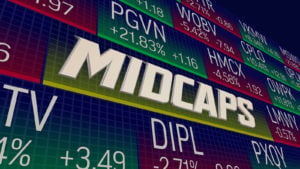Of the 100 largest ETFs by assets, Vanguard has five in the top 10, 12 in the top 25, and 32 in the top 100. That makes sense, given it is the second-largest ETF provider by assets under management, with $2.55 trillion as of April 9.
However, Vanguard has 86 ETFs. Not all of them are in the top 100. It has 18 ETFs with net assets of less than $1 billion. That’s about 21% of its ETFs.
The largest ETF provider by net assets is iShares, with $2.75 billion spread across 411 ETFs. Of those, 58% have net assets of less than $1 billion. It would be much easier to do this exercise with iShares ETFs.
That’s not to be.
Here are three smaller Vanguard ETFs to consider for your portfolio.
Vanguard Total Corporate Bond ETF (VTC)

The Vanguard Total Corporate Bond ETF (NASDAQ:VTC) has net assets of $981 million and charges 0.04% or $4 per $10,000 invested.
The ETF tracks the performance of the Bloomberg U.S. Corporate Bond Index, which provides investors with exposure to investment-grade U.S. corporate bonds. Although the overall portfolio has an intermediate-duration focus, it does provide exposure to short (40%), intermediate (28%), and long-term maturities (32%).
The ETF owns 7503 corporate bonds, 454 less than the index. It holds them through three Vanguard ETFs: Vanguard Short-Term Corporate Bond ETF (NASDAQ:VCSH), Vanguard Intermediate-Term Corporate Bond ETF (NASDAQ:VCIT), and the Vanguard Long-Term Corporate Bond ETF (NASDAQ:VCLT).
The bonds’ average coupon is 4.2%, with a 5.3% yield to maturity and an average duration of 7.0 years. The portfolio is rotated once every 10 years or so.
The top three countries by weight are the U.S. (84.9%), the UK (4.3%), and Canada (3.2%) €”bonds with credit ratings of BBB or A account for 92% of the portfolio.
You won’t get rich from VTC, but the 30-day SEC yield is a healthy 4.04%.
Vanguard S&P Mid-Cap 400 Growth ETF (IVOG)

I’m a sucker for mid-cap stocks, so the Vanguard S&P Mid-Cap 400 Growth ETF (NYSEARCA:IVOG) just had to make my trio of smaller Vanguard ETFs. It helps that Morningstar.com gives it a four-star rating.
If you’re unfamiliar with the S&P MidCap 400 Index, it’s a collection of 400 mid-cap stocks representing approximately 5% of the U.S. equity market. IVOG tracks the performance of the S&P MidCap 400 Growth Index, which provides exposure to 245 growth stocks from the 400 in the parent index.
The average stock in IVOG has a median market cap of $9.7 billion, a five-year earnings growth rate of 18.8%, and a P/E ratio of 21.6x. It turns the portfolio every two years.
The top three sectors by weight are industrials (28.20%), consumer discretionary (17.80%), and technology (11.70%). The fund’s top 10 holdings account for 12% of its $961.3 million in net assets.
Of the top 10 holdings, I like Vistra (NYSE:VST), Williams-Sonoma (NYSE:WSM), and Lennox International (NYSE:LII).
It charges a reasonable 0.15%.
Vanguard US Quality Factor ETF (VFQY)

Vanguard US Quality Factor ETF (BATS:VFQY) doesn’t track the performance of a particular index.
Instead, portfolio managers use a quantitative model to evaluate stocks of all market caps and construct a portfolio of companies with solid fundamentals. These fundamentals include strong profitability, sustainable earnings, and healthy balance sheets.
VFQY’s website states the portfolio “includes a diverse mix of stocks representing many different market capitalizations (large, mid, and small), market sectors, and industry groups.”
The 362 stocks in its portfolio have a median market cap of $27.3 billion, a five-year earnings growth rate of 15.4%, and a P/E ratio of 19.6x. Large-cap stocks account for 43% of the ETF, mid-caps (25%), and small caps (32%).
The top three sectors by weight are industrials (22.20%), consumer discretionary (20.30%), and technology (19.80%). Its top 10 holdings account for 15% of the fund’s net assets. Of the top 10 holdings, the only stock I don’t like is 3M (NYSE:MMM). It just has too many issues.
The ETF has $334.2 million in net assets and charges 0.13%.
On the date of publication, Will Ashworth did not have (either directly or indirectly) any positions in the securities mentioned in this article. The opinions expressed in this article are those of the writer, subject to the InvestorPlace.com Publishing Guidelines.
Will Ashworth has written about investments full-time since 2008. Publications where he’s appeared include InvestorPlace, The Motley Fool Canada, Investopedia, Kiplinger, and several others in both the U.S. and Canada. He particularly enjoys creating model portfolios that stand the test of time. He lives in Halifax, Nova Scotia.
